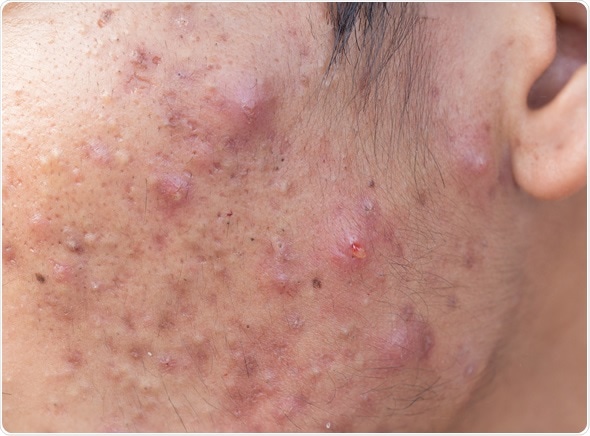Acne is a skin disorder which involves the pilosebaceous units of the skin. These consist of a hair follicle, which gives rise to skin hairs, and the attached sebaceous gland, which produces sebum.
Sebum is a greasy secretion which keeps the hair and skin moisturized. The sebum escapes from the hair follicle through the narrow canal, along with dead cells and other debris. When this pore is blocked, sebum and other material piles up behind the plug, causing a visible skin bump. This can become inflamed or infected, leading to the formation of a pimple or zit.
Colonization of the hair follicle by the skin commensal bacterium Propionibacterium acnes causes the release of still more inflammatory chemicals which worsen the condition. Acne is most common over the face, neck, upper chest and back, and the upper arms.

Man with problematic skin and scars from acne (scar). Image Copyright: frank60 / Shutterstock
Gender Differences
Possibly because acne is related to the activity of androgens, the male sex hormones, young males are more prone to develop severe forms of acne. With this said, 80% of adult acne occurs in women.
In young women, the outbreaks of acne are observed to occur in relation to menstrual periods. Over a period of time, as women approach their late thirties, acne tends to subside. This is not a rule, however, and some women have their first episode later in life. This usually appears after the age of 25 years, and is called adult-onset acne. It is characterized by deep painful nodular and inflamed lesions.
Complications of Acne
Acne is minor in relation to its physical consequences, but major in relation to the impact it has on the individual’s appearance, personality, and mood. Severe forms of acne can disfigure the person through scarring, emotional distress, and often the required plastic surgery to correct them to some extent.
Depression and a negative body image are linked to acne in many cases. Fortunately, acne can be treated and even prevented in some cases.
Types of Lesions in Adult Acne
The different forms of acne range from a comedo to cystic nodular acne. They are described as follows:
- The comedo: This is the lesion that is diagnostic of acne, and is nothing but a blocked hair follicle pore. It can be either open or closed, depending on whether the pore is open to the skin or covered by it. An open comedo is often blackish or brownish in color as the sebum gets oxidized to darker components, and also because of coloration by melanin granules from the keratinocytes (keratin-producing cells) that line the hair follicle. These are called blackheads. Whiteheads are closed comedos, appearing as whitish bumps under the skin.
- Papular acne: This is a mild form of acne with one or more papules (skin bumps), but little inflammation or infection.
- Pustules: This refers to the occurrence of infected comedos, which contain pus, are painful, and appear reddish around the base. They may burst and release pus.
- Nodules: These are severe lesions which occur deeply in the skin, and are caused by both infection and inflammation. They are painful, and may result in scarring.
- Cysts: These represent the most serious form of acne, and are large painful lesions containing large amounts of pus. They usually resolve with disfiguring scars.
Causes of Adult Acne
Acne may arise in adults due to the following:
- Hormonal fluctuations such as in pregnancy, polycystic ovarian syndrome, or the menstrual cycle
- Drugs such as oral contraceptives, antidepressants and anticonvulsant medications may precipitate acne
- Friction on the skin, such as that caused by a backpack or a helmet, can cause or aggravate acne
- Oily make-up
- Family history of acne increases the risk of getting acne
- Stress may aggravate acne in a person who always has the condition
Minimizing Acne
- It is best to wash the face with mild soap and warm water, without scrubbing the skin.
- Eating a balanced diet with plenty of vitamins will help the skin look fresher, but doesn’t help prevent acne.
- Acne lesions should not be handled, if possible – they should not be picked or squeezed
- Oily hair should be kept clean and away from the facial skin.
- Appropriate makeup, among the non-comedogenic (non-oil-based) varieties, should be used.
- Tight-fitting clothing or gear, such as helmets or backpacks, should be avoided where possible.
Treatment of Acne
If you have acne, try a tested over-the-counter medication or see a doctor if there are many lesions. You may be prescribed one or more of the following medicated creams or lotions:
- Benzoyl peroxide which reduces sebum production
- Resorcinol, salicylic acid, or sulfur, which have keratolytic or skin-softening effects and break down the lesions
These are usually used for 6-8 weeks, following which resolution should occur. If not, you may have to see a dermatologist (skin specialist).
Further Treatment
Advanced treatment may consist of:
- Retinoic acid or its derivatives, some of which require strict birth control
- Antibiotic creams to control local infections
- Minor surgery to remove or drain large nodulocystic lesions
Oral Medication
This may consist of:
- Antibiotics to control follicle infections
- Isotretinoin, a powerful vitamin A derivative able to control and treat acne but which can severely damage developing fetuses
- Oral contraceptives to reduce hormone levels in the body
- Spironolactones to reduce androgen levels in the body
Surgery
Dermabrasion refers to resurfacing the facial skin, to even its contours. It may be done by ablative or non-ablative laser. Chemical peels are sometimes used for the same purpose. Photodynamic therapy is also being studied for this purpose, and seems to give favorable results in removing acne scars.
References
Further Reading